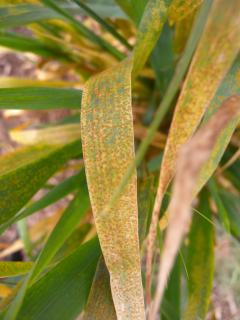Barley leaf rust
- Gibson
Plant Pathologist Andrea Hills (DPIRD) recently found barley leaf rust (BLR) on Cyclops, Minotaur and Laperouse barley in a trial at the Esperance Downs Research Station at Gibson. The rust infection was relatively mild and localized primarily in the lower part of the crop canopy.
BLR develops rapidly in moist conditions when temperatures are between 15 to 22°C and when leaves are frequently wet from dew or rain. As temperatures increase, more BLR is expected to occur.
The varieties Cyclops and Minotaur are susceptible (S) to BLR in both seedling and adult growth stages, while Laperouse barley is moderately susceptible (MS) to BLR in the seedling growth stage and moderate susceptible to susceptible (MSS) in the adult stage. To check disease ratings for other barley varieties with respect to BLR, refer to DPIRD’s 2023 WA Crop Sowing Guide – Barley.
The likelihood of economic return to fungicide application is dependent on variety susceptibility, severity of infection, weather outlook for the next three weeks, yield potential, and growth stage of crop. In general sprays after flowering (into grain fill) are less likely to provide economic return, particularly if warmer and drier conditions are possible in the next few weeks. It is important to consider withholding periods for fungicides, and this information can be found on product labels.
For a list of registered foliar fungicides, visit DPIRD’s registered foliar fungicides for cereals in Western Australia page.
Growers also need to consider potential disease carryover into the 2024 season if leaf rust is not adequately treated this year and if summer cereal hosts are not controlled. BLR needs living plant tissue to survive to infect the new crops.
Rust pathotype testing
Growers and agronomists are encouraged to send samples of all rusts for pathotype testing at any time of the year to the Australian Rust Survey. Rusts need to be to be continuously monitored for possible new strains. New strains can impact existing varieties, and provide wheat breeders valuable information for developing new resistant varieties. Infected leaf samples should be mailed in paper envelopes (do not use plastic wrapping or plastic lined packages) along with your details and collection information (location, variety etc.) directly to:
The University of Sydney
Australian Rust Survey
Reply Paid 88076
Narellan NSW 2567
Optional free reply-paid envelopes can be ordered from The University of Sydney. For further details, refer to The University of Sydney’s Australian Cereal Rust Survey page.
More information
For more information on BLR and how to manage it refer to DPIRD’s diagnosing barley leaf rust page.
For more information on leaf rusts, contact Plant pathologists Ciara Beard in Geraldton on +61 (0)8 9956 8504, Kithsiri Jayasena in Albany on +61 (0)8 9892 8477, Geoff Thomas in South Perth on +61 (0)8 9368 3262, Kylie Chambers in Northam on +61 (0)8 9690 2151 or Andrea Hills in Esperance on +61 (0)8 9083 1144.
Article authors: Cindy Webster (DPIRD Narrogin).
Article input: Kithsiri Jayasena (DPIRD Albany) and Andrea Hills (DPIRD Esperance).

